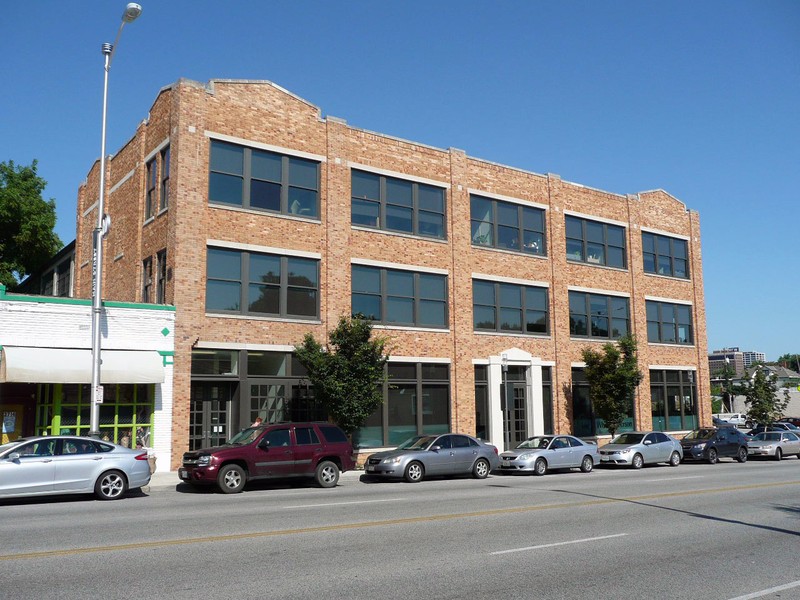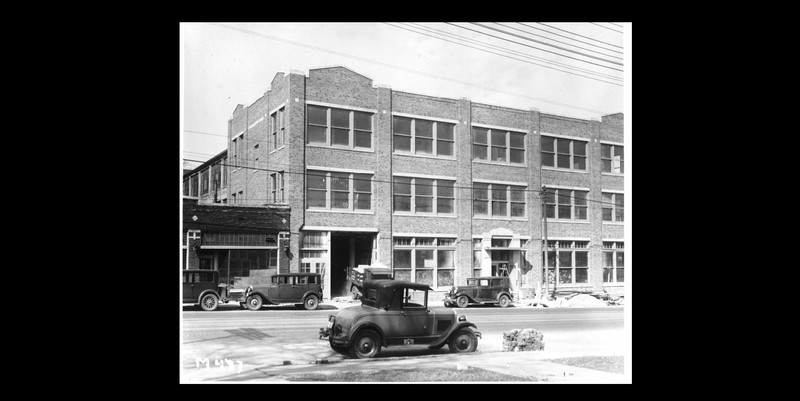Goodenow Textiles Company Building
Introduction
Text-to-speech Audio
Constructed in 1930, the Goodenow Textiles Company Building represented the growth of a family business from a small operation in 1909 to one doing upwards of $100 million in business by 1945. The company focused on undergarments and hosiery, and its growth mirrored that of the garment industry in Kansas City. The company's growth also mirrored the mass adoption of standardized undergarments around the time of World War I when the mass-produced, one-piece, elastic-banded underwear commonly worn today regardless of social and financial status became more common. This production facility was designed with design ideas of the Progressive-Era; with a factory that allowed for plenty of light and offered workers a better environment with the goal of increasing production as a result of the better workspace.
Images
Goodenow Textiles Company Building

Goodenow Textiles Company Building from the 1930s

Backstory and Context
Text-to-speech Audio
The Goodenow Textiles Company Building served as the home to the Goodenow Textiles Company, a nationally known manufacturer of men's underwear and a significant contributor to the Kansas City garment industry. The open floor plan and spatial arrangements reflect technological changes in industrial design consisting of reinforced concrete and suitable for assembly line manufacturing. The factory building, located outside Kansas City's bustling garment district with rail spurs to freight yards, also reflects the beginning of the shift from rail to vehicular transportation of supplies and finished goods in the post-World War I period. Its design reflects principles introduced during the 1920s and inspired by Progressive Era ideals that light, comfort, and positive workplace relationships increased worker productivity.
In the last half of the nineteenth century, Kansas City, Missouri, developed into one of the nation's major railroad hubs, which occurred concurrently with significant population growth and a boom in industrial development and commercial growth, including the garment industry. In 1900, eleven factories in Kansas City manufactured men's and women's clothing with a value of approximately $1.2 million. By 1945, more than eighty garment factories operated in Kansas City, doing an annual business between $75 million and $100 million and employing between 6,000 and 7,000 workers.
Frank Goodenow began his career in the garment industry in 1901 when he went to work for the Chicago-Kenosha Hosiery Company in Wisconsin, which later co-founded a company that became Jockey International. Frank Goodenow married in 1909 and, together with his wife and his new cousins-in-law, Mr. and Mrs. Arthur Brookfield, moved to Kansas City to start a new business. Goodenow and his childhood friend from Chicago, Arthur Brookfield (who also moved to Kansas City), formed the Goodenow-Brookfield Knitting Company in 1909, which became evolved into the Goodenow Textiles Company. The company moved several times in its early years, reflecting its growth (and the entire industry) as each space proved larger than the previous one. World War I profoundly influenced the industry as garment makers mass-produced clothes for troops. Thus, during the first decades of the twentieth century, clothing production shifted from homemade garments and tailor-made clothing to mass-produced, ready-to-wear items, including underwear.
In fact, the history of underwear changed substantially during the twentieth century. During the eighteenth century and much of the nineteenth century, undergarments for American women and men consisted of a long shirt hanging from shoulders to calves called a chemise or vest. During the last half of the nineteenth century, pants worn as undergarments came into use, as did two-piece garments similar to today's long underwear, although baggier in form. Working-class men usually wore woolen undergarments while middle- and upper-class men considered it unnecessary, notably given their limited level of activity.
Before World War I profoundly influenced the garment industry, a one-piece "union suit" emerged during the first decade of the twentieth century and grew popular, notably as companies made advancements in the style's design. During World War I, underwear became shorter, had elastic bands (instead of buttons), and consisted of breathable materials; the "boxer" was born, and sales soared. With the onset of mass production after the war, companies produced men's underwear in record volumes, meeting consumer demand for clean, durable undergarments. (By World War II, men could also buy bikini briefs and colored underwear.) Like many industries during the Gilded Age and into the early 1900s, thousands of European immigrants provided ample low-cost labor. Industrial (technological) changes plus an abundant labor force sped the process of producing underwear from three days to one hour.
Initially, the Goodenow Textiles Company manufactured products including hosiery and the "Good-knite" pajamas line. After World War I, the company began concentrating on the men's summer union suit. The company's success forced the company in 1919 to add to its factory to meet the increased demand. Also, in 1919, Brookfield left the company, so Frank Goodneow's brother, Fred, joined the company as its Vice President. Not long thereafter, the company had to relocate to an even bigger location within the city's wholesale garment district. In the new location, the Goodenow Textiles Company raised its production from 750,000 sets of underwear per year to one million sets in 1928. Yet again, the company outgrew its production space. So, in 1929, before the onset of the Great Depression, the company announced plans to move (again) to a bigger facility.
The new facility would not only allow for greater production but also adhere to new ideas about providing workers with better workspaces, which would also enhance production. Furthermore, the new location offered insight into the evolution of transportation. The growing popularity of automobiles (notably, trucks) made it possible to build a facility in a place away from the city's railroad freight hub. The new (now historic) factory opened in 1930 and, at 40,000 square feet, was twice as big as its previous facility. The Goodenow Textiles Company Building allowed for a boost in both production, and the company increased its workforce from 200 to 300 employees. Despite the Great Depression, the company continued to grow; the company expanded into international trade by 1939.
The company occupied this building for twenty-one years. In 1951, the Goodenows sold the business to James Lenaghan, the company's accountant. He moved operations to Monett, Missouri, but the Lenaghan family continued to own the Main Street building until 1977. Afterward, the Main Street building occupants included various businesses such as a stationary company, photographers, and a balloon business.
Cite This Entry
Powers, Mathew and Clio Admin. "Goodenow Textiles Company Building." Clio: Your Guide to History. August 27, 2021. Accessed March 29, 2025. https://theclio.com/entry/139358
Sources
Johnson, Susan Richards. "Nomination Form: Goodenow Textiles Company Building." mostateparks.com 2003. https://mostateparks.com/sites/mostateparks/files/Goodenow%20Textiles%20Co.%20Bldg.pdf
Schwenk, Sally F. "Nomination Form: Railroad Related Historical Commercial and Industrial Resources in Kansas City, Missouri." mostateparks.com. 2010. https://mostateparks.com/sites/mostateparks/files/Railroad-Related%20Historic%20Commercial%20and%20Industrial%20Resources%20in%20KC%2C%20MO.pdf.
By Mwkruse - Own work, CC BY-SA 3.0, https://commons.wikimedia.org/w/index.php?curid=42359861
https://pendergastkc.org/collection/9130/10000727/goodenow-textile-company-building/49973

